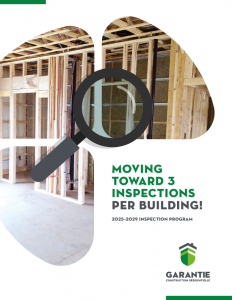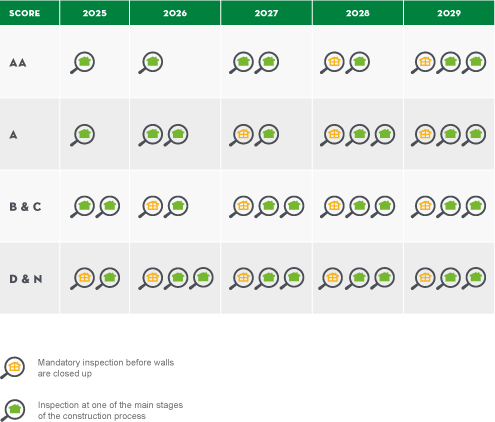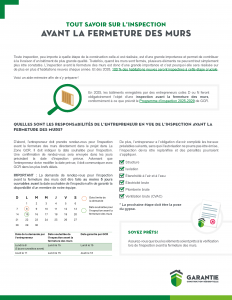After a building is inspected, an inspection report is written and sent to the contractor within three working days of the inspection. The report will identify the incidents of non-compliance observed on site by level of risk, any preventive notifications issued, best practices followed by the contractor (see section below), and finally, the overall inspection rating out of 90. Details about the inspection rating system are provided in the table below.
| Observation type |
Impact on the technical rating |
Impact on the collaboration score if not corrected |
| Best practices |
+ 2 points (max 10 points) |
s.o. |
| Preventive notification |
No impact |
Based on risk level |
| Low risk incident of non-compliance |
– 1 point |
-1 point |
| Average risk incident of non-compliance |
– 2 points |
– 2 points |
| High risk incident of non-compliance |
– 8 points |
– 8 points |
To determine a contractor’s technical rating (one of the components of the Cote Qualité GCR score*), GCR draws on the contractor’s past inspections. A project gets a rating for each inspection based on the incidents of non-compliance found in the inspection and the best practices that have been incorporated. An average rating is then calculated for each project.
If a contractor fails to correct the incidents of non-compliance found on site or provide the required documents, up to 10 points may be deducted directly from their Cote Qualité GCR score.
The contractor’s project ratings are averaged out to give a technical rating, which follows the grading scale below :
- AA : 91 and more
- A : 81 to 90
- B : 71 to 80
- C: 45 to 70
- D : Less than 45
- N : Not scored
Risk Scale
When an inspection takes place, the GCR inspector may observe incidents of non-compliance. The contractor is required to correct these, as detailed in the section below. Such incidents of non-compliance and preventive notifications are recorded in an inspection report that will be sent to the contractor within three working days. In this section, we will explain the types of observations that the report might include.
Preventive notification
If, based on what it observes on site, GCR anticipates that any elements that have not been carried out or completed may contain deficiencies once finished, it will issue the contractor a preventive notification. The expectation is that the contractor will take any necessary action to bring the elements into compliance by the time the construction is completed. The contractor must provide evidence of the corrections. If the evidence is deemed insufficient, GCR may deduct points from the contractor’s inspection rating and require further corrective action.
Non-compliance
An incident of non‑compliance occurs if the GCR inspector finds any element of the construction to be non‑compliant with the current Quebec Construction Code, regulations, best practices and/or manufacturer requirements. Incidents of non-compliance are automatically categorized by level of risk.
Low-risk : these incidents meet the analysis criteria for risk level A or B
Average-risk : these incidents meet the analysis criteria for risk level A and B
High-risk : these incidents meet the analysis criteria for risk level C

Conditions for an AA Technical rating
A contractor that wants to maintain or obtain an AA technical rating must meet the following three criteria :
- Demonstrate that at least one best practice has been applied for each project inspected
- Obtain an average of at least 91 points on inspection reports
- Lose no collaboration points
Cote Qualité GCR
Every contractor accredited by GCR will be assigned a Cote Qualité GCR. This score is assigned by assessing financial ratios, customer satisfaction and the quality of buildings constructed. Contractors who have not yet received a technical assessment are temporarily given a score of N (not scored).
The Cote Qualité GCR helps ensure fair risk management for all accredited contractors.
Note : For a business with a score of N to be assigned a Cote Qualité GCR, it must submit its financial statements and have been subject to inspections totalling 3.0 points. For example, 3.0 points can be achieved through two inspections, one for the exterior finish (1.5) and one for water and air tightness (1.5). These two inspections must be carried out on two different buildings for detached, semi‑detached or row-type single-family buildings.





